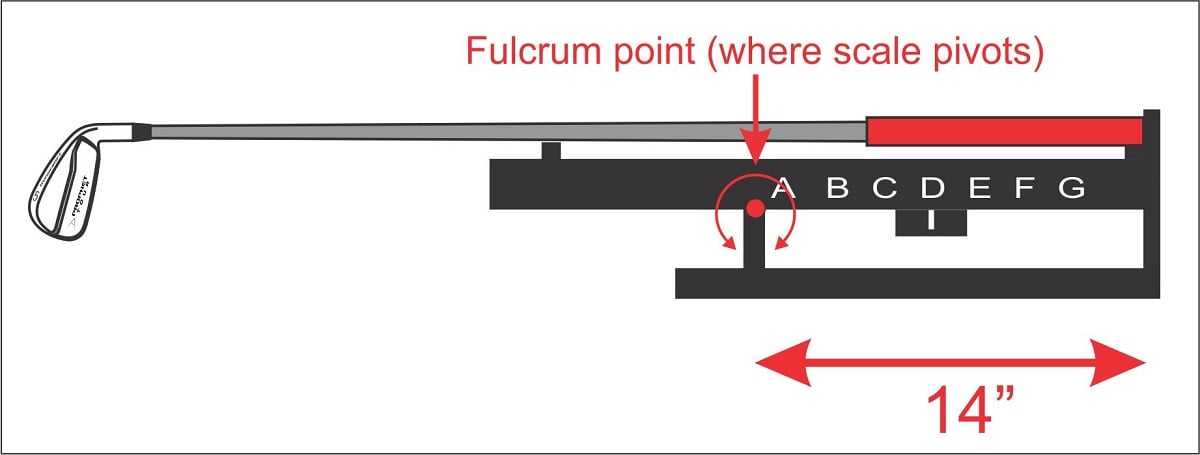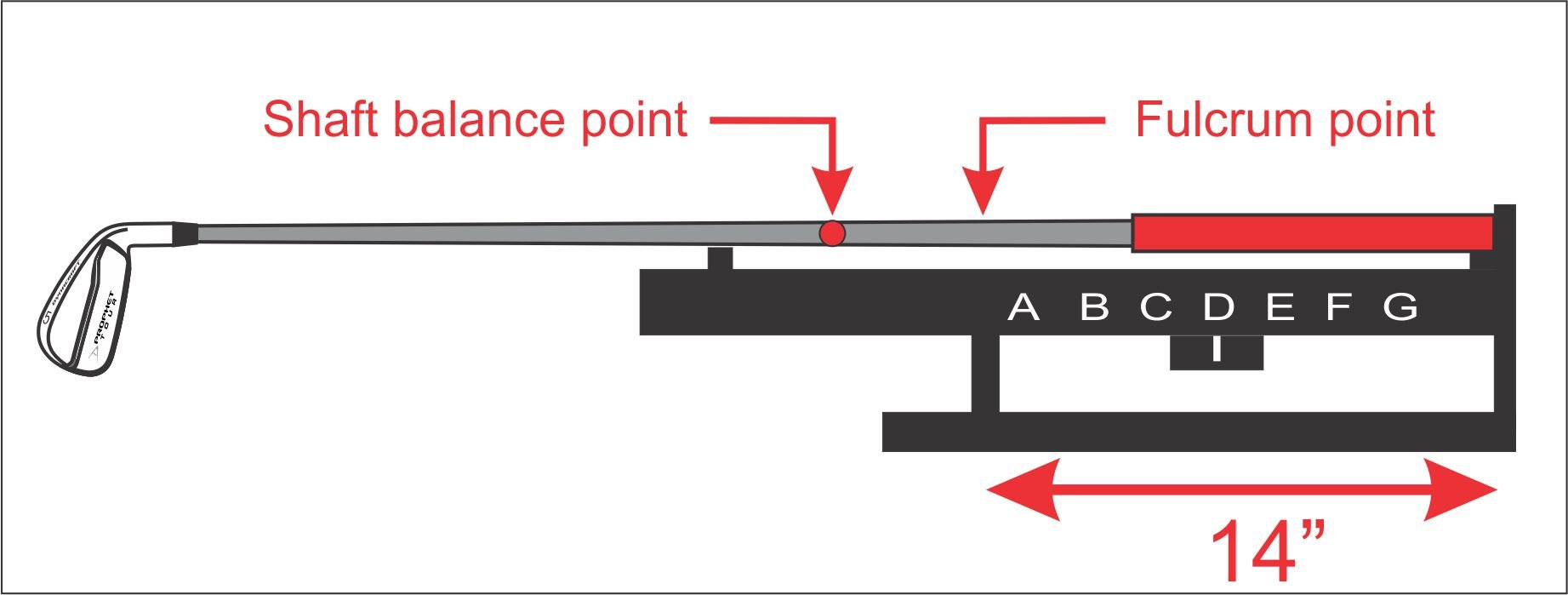
Golfers are constantly looking to increase the distance they hit the ball. One way is reducing the overall weight of the club so it can be swung faster and that is mainly a function of the shaft weight. But re-shafting to a lighter weight shaft does have some consequences.
What happens to the swing weight with a lighter weight golf shaft?
Some golfers assume if the shaft is lighter, a higher percentage of the weight is concentrated near the head resulting into an increase in swing weight (or spelled swingweight). However, that is not the case and let us show you why. If you look carefully at a golf swing weight scale, there is a fulcrum point or position that club pivots around located 14" from the end of the grip. That is a constant.
To obtain a swingweight reading, the club is placed onto the scale and a sliding weight is moved back and forth until the club balances about the pivot point. Then the swingweight is read from the sliding scale (for example C9, D2, D5, etc.) We remember as a kid playing on a teeter totter the principles of equilibrium where two kids of different mass can balance the teeter tooter depending on how far they are apart from the fulcrum point. That is how a swingweight scale works.
If we look at the diagram above of the scale, it is easy to understand that if the head weighed more, then the the arm of the scale would rotate counterclockwise and require the sliding weight to be shifted to the right increasing the swingweight. If the grip weighed more, then the arm of the scale would rotate clockwise and require the slighting weight to be shifted to the left decreasing the swingweight. Conversely, if the head or grip were lighter, the opposite scenarios would occur. But what about the golf shaft?
Shaft Weight and Balance Point
We know that any weight added to the head size of the fulcrum point increases the swingweight and any weight added to the grip side decreases the swingweight. When we look at the shaft as one of the components, when need to know where the balance point of the shaft is. We have denoted this with the red dot on the shaft and it is located on the head side of the fulcrum point. This makes complete sense because most of the shaft resides on that side. Even on a 35.5" wedge, the balance point of the shaft will remain on the head side of the fulcrum.

As we reduce the shaft weight (and the shaft length and balance point are the same), then the swingweight will lower. How much? It will vary depending how much lighter the shaft is and the length of the shaft. On a driver, a 7-gram reduction in weight will be @ 1 swingweight point, but on a sand wedge it might require a 15-gram drop in weight to reduce by the same 1 swingweight point.
How do you remedy the situation?
To re-balance the club after re-shafting to maintain the original swingweight, there are several things that you can do.
- Increase the club length (each 1/6" = 1 swingweight)
- Add tip weights prior to installing the shaft
- Add lead tape to the head
- Add a different weight screw or weight to the head if one is available
Final thoughts
There are exceptions to every rule such as when the balance point of the shaft changes dramatically. But we will leave that topic to another blog post. Hopefully, you have a better understanding of the relationship between shaft weight and the swingweight of the club. You can use our golf club building swing weight calculator to see how shaft weight and balance point affect the overall swing weight of a golf club.






Im confused , is the implication that two identical heads one on a 105 gm shaft and one on a 125 gm shaft of the same length and balance point will have the same swingweight ?
The reason i am confused is that i have just this with me now and the lighter shafted club ‘ feels’ heavier to swing ?? The clubs weigh in total 21 gms different so theres a gm gained or lost somewhere but i doubt i could feel that .
Also if i balance the clubs on their natural pivot point the lighter club is by eye (im a carpenter) 1” behind or offset back or shorter head end than the heavier which would be right with what i am experiencing .
Im very confused as to why this is , i cannot believe they would be the same swingweight ?
Let's say you have two identical heads with the same gram weight and lie angle. If you install 105 shaft in one head and a 125g shaft in the other at the same length, then the swingweight will be lower with the 105g shaft (assuming the balance point is in the same exact location). The balance point of the shaft resides on the head size of the fulcrum point, so the heavier weight shaft would react as you had a heavier head.
If the two clubs you have are the same swingweight, then the culprit is one, the balance point on the lighter shaft is slightly more toward the tip, or two, the grip weights are different. The third reason could be the lie angle may not be exactly the same. A flatter lie would cause a slight increase to the swingweight. It is small like 1/3 of a point for a 1 degree change. Double check the overall length of the two clubs. A sixth of an inch (0.167") variation is a one point change. Or, it could be a combination of these.
To clarify a previous answer, changing from DG 120s to DG 105s, is the 1-2 point change heavier or lighter? I have DG 120s with a D4 swing weight, and am switching to DG 105s. Would I change my swing weight to D2 or D6? Thanks in advance!
The swingweight should be @ 1-2 points lighter like D3 or D2.
I was comparing my 7 iron to a trial 7 iron. The trial iron was a interchangeable cart club fitted with a 105g steel shaft. My club is fitted with a 127-130g shaft. I was being measured using a launch monitor.
I was allowed to take the trial club home which gave me the opportunity of measuring it with my rudimentary Golfsmith equipment.
Besides inevitable differences in lie and loft, I noticed that the trial club was coming in with a swing weight of D5, (3 heavier than standard).
I immediately thought, before reading this article, that fitting a head with a lighter shaft would increase the swing weight.
Obviously that is not the case, but the fact is the swing weight is high and there's a light shaft fitted.
So what could be the cause of this?
I am concerned that due to the swing weight being higher than spec I am not getting a true picture of what advantages I would gain from the lighter shaft. I am worried that it is the head of the club that is clouding judgement.
Can anyone shed any light?
I am currently trialing lighter shafts in order to increase my club head speed as I have lost distance, (age and infirmity).
I have been on a launch monitor in a controlled environment comparing 7 irons with different shafts with my own 7 iron which is fitted with a TT DG R300. It measures at D2 which is standard.
The trial iron that I've hit best is weighing in around 25g lighter than mine and the SW is D5. I hit it 10 yds further on the carry.
The trial iron is a cart trial club that is interchangeable. I'm thinking this has something to do with the heavier swingweight, but don't feel that is the whole story.
I am wondering if swingweight is actually taken into consideration with interchangeable heads. Surely it's not as simple as taking the same weight head from a heavier shaft to a lighter shaft and expecting the swing weight to remain standard.
The swing weight at D5 is 3 more than standard. If 1 SW = 3g, then another 9g could be deducted from the overall weight by reducing the SW to D2.
Or am I barking up the wrong tree?